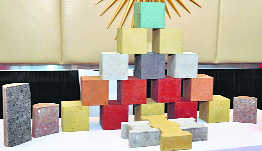Massive urbanisation and infrastructure growth in the country has also seen a lot of change in the construction practices. With “going green” becoming the main mantra in this industry the techniques as well as construction materials have evolved drastically in the past few years. Currently, India ranks second as the country with the largest number of green buildings after USA. Even the construction materials have become more eco-friendly and perfectly suited for “green” buildings. Anil Banchhor, Chief Executive, Concrete Business, ACC Limited, talks about the new avtar of concrete that is eco-friendly as well as more design friendly. Addressing the needs of the innovations,the group recently introduced a new line of allied products that are supplied in the form of ready-to-use mortar. Excerpts:
What is the current scenario in the concrete business? Why is there a need to innovate and re-invent?
Ready Mix concrete (RMX) business continues to perform well despite the fact that in 2014, the Industry witnessed the entry of more players. Concrete market is greatly fragmented and with increased participation by the unorganised segments, there exists a pressure on pricing. However, sale volume has improved by 18 per cent.
Demand for concrete is expected to revive in almost all markets across the country and is likely to be stronger in metro markets like Mumbai, Bengaluru, Chennai and Delhi. Major demand is expected to come from large investments in infrastructure and development of real estate across India in proposed future cities. Ready Mix Concrete is expected to maintain the momentum and contribute to the overall business with enhanced participation.
What are the different ways in which building materials can help increase the sustainability or 'green' quotient of a building?
Modern home owners can now build or rebuild their homes, using a variety of 'smart' and green building, materials such as:
n Replacing natural sand with crushed rock fines made from dolomite, ballast, granite, limestone etc. Not only does this help to preserve natural sand (the use of which is banned in a few states) but it also significantly increases the compressive strength and durability of the concrete mix, because of the absence of clay lumps and vegetation.
n Replacing clay bricks with a eco-friendly fly ash-based composition. Fly-ash bricks are superior in quality than clay bricks in terms of strength, water absorption, efflorescence and other parameters. Using fly-ash bricks helps reduce carbon footprint and preserving land mass for other use.
n The third important component of construction is concrete, which can be customised to serve several purposes. Some of these are:
Weather proofing: A special composition helps increase concrete's resistance to sulphates, reduces chloride-ion penetration, and improves resistance to severe weather conditions.
Beautification: Concrete need not always be mundane and now it can be printed or stamped for making decorative surfaces on porch, pavements, footpath and walkways. Concrete can be used to make complex patterns for a decorative porch or a naturally blending pathway in a garden, which are more attractive and pleasing.
Water drainage: Depleting ground-water level is a major concern in areas where buildings and roads are coming up. But now high performance porous concrete is available that allows water drainage that increases ground-water level.
Reducing electricity bills: Concrete is now designed to provide indoor insulation. A layer of customised concrete can be applied over the top layer of the roof slab, for creating thermal insulation. With this the energy consumption is reduced to a great extent leading to reduction in electricity bills.
One hears a lot about retrofitting. How can this increase the “green quotient” of a building and how cost-effective it is?
Retrofitting is a technique, through which scores of old buildings and homes in the country have been transformed by using non-toxic, recycled and environmental friendly building materials. A green building can save on an average between 25-30 per cent on water and electricity consumption. Therefore the costs incurred in retrofitting can easily be covered through the savings within maximum 5 years.
What has been the consumer response to new building materials?
Consumers as well as builders have reacted very positively to new eco-friendly products and acceptance is increasing looking at benefits in cost, time saving, productivity, value and sustainability aspects.
— As told to Geetu Vaid
Unlock Exclusive Insights with The Tribune Premium
Take your experience further with Premium access.
Thought-provoking Opinions, Expert Analysis, In-depth Insights and other Member Only Benefits
Already a Member? Sign In Now










